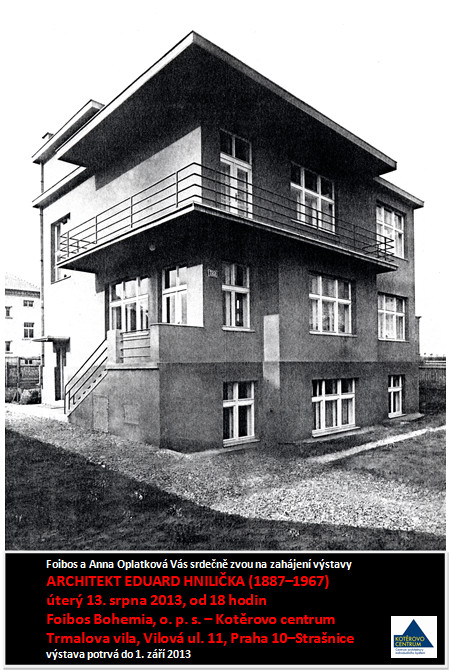
Exhibition "Ing. arch. Eduard Hnilička (1887–1967)"
 |
Ing. Arch. Eduard Hnilička (1887–1967)
A creatively gifted boy from a clerical family studied at a German secondary school in Prague, then at the School of Architecture at Czech Technical University under professors Koula, Šulka, and Balšánek, graduating in 1913. He actively engaged with historical architecture in Prague, photographing, drawing, documenting, and surveying.
Along with architect Jiří Kroha, he participated in preparing his exhibition at the House of Artists in Prague in 1920. Both architects worked in a studio in Karlín and collaborated on many competition designs with architects Novotný, Janák, and Kvasnička. They also published their works and designs in magazines such as Styl, České slovo, Časopis čs. architektů, and Architektonický obzor. From the 1930s onwards, they worked independently.
Among Hnilička's building realizations are parts of the villa development in Ořechovka, the Homes for Starodružiníků in Dejvice, the villa colony Šumava in Smíchov, the villa of the primary of the Czech Quartet, Prof. Karel Hoffman, in Prague–Podolí, state houses in Semily, Bílina, Prague Dejvice, Vinohrady, and Palmovka. He also contributed to the construction of Masaryk Schools in the early republic with realizations in Mariánské Lázně, Lubenec, Nové Sedlo, and Rudolice. For private construction, he designed villas in Prague in Smíchov, Strašnice, Zbraslav, Dolany near Kralupy, and Senohraby.
A special commission involved the construction of YMCA hotel multifunctional buildings with a pool and gym in Prague Na Poříčí, Banská Bystrica, and Znojmo from the 1930s. Notable technical constructions include the hangars at Ruzyně airport (with architects Hruška and Sláma), the regulating station of the Electric Enterprises of the Capital City of Prague in Libeň, and designs for exhibition pavilions for Sigma pumps Sigmund.
He devoted much time to his work on the committee of the Club for Old Prague, where as an illustrator and photographer he collaborated on anthologies and books with Dr. Poch, Wirth, Merhout, and his friend architect Hübschmann. He also engaged in graphic work on themes related to Prague, nature, and heritage protection, small graphics, holiday cards, and ex libris. Since 1912, he collaborated as a graphic designer with his wife’s brother – Emil Pacovský, a theory of art and publishing expert, on the graphic edition Veraikon. His well-equipped graphic workshop was also used by colleague architect Jan Kotěra, in whose technical studio Hnilička worked from 1915 to 1918. His large oil paintings mainly depict the themes of Skochovice, the summer residence of his family.
He was married twice. Two of his three daughters, Květa Radová and Eliška Kafková, were professional artists.
Eduard Hnilička died in 1967 and is buried at the Olšany cemetery in Prague.
His estate is stored in the Architecture and Construction Archive of the National Technical Museum in Prague.
A creatively gifted boy from a clerical family studied at a German secondary school in Prague, then at the School of Architecture at Czech Technical University under professors Koula, Šulka, and Balšánek, graduating in 1913. He actively engaged with historical architecture in Prague, photographing, drawing, documenting, and surveying.
Along with architect Jiří Kroha, he participated in preparing his exhibition at the House of Artists in Prague in 1920. Both architects worked in a studio in Karlín and collaborated on many competition designs with architects Novotný, Janák, and Kvasnička. They also published their works and designs in magazines such as Styl, České slovo, Časopis čs. architektů, and Architektonický obzor. From the 1930s onwards, they worked independently.
Among Hnilička's building realizations are parts of the villa development in Ořechovka, the Homes for Starodružiníků in Dejvice, the villa colony Šumava in Smíchov, the villa of the primary of the Czech Quartet, Prof. Karel Hoffman, in Prague–Podolí, state houses in Semily, Bílina, Prague Dejvice, Vinohrady, and Palmovka. He also contributed to the construction of Masaryk Schools in the early republic with realizations in Mariánské Lázně, Lubenec, Nové Sedlo, and Rudolice. For private construction, he designed villas in Prague in Smíchov, Strašnice, Zbraslav, Dolany near Kralupy, and Senohraby.
A special commission involved the construction of YMCA hotel multifunctional buildings with a pool and gym in Prague Na Poříčí, Banská Bystrica, and Znojmo from the 1930s. Notable technical constructions include the hangars at Ruzyně airport (with architects Hruška and Sláma), the regulating station of the Electric Enterprises of the Capital City of Prague in Libeň, and designs for exhibition pavilions for Sigma pumps Sigmund.
He devoted much time to his work on the committee of the Club for Old Prague, where as an illustrator and photographer he collaborated on anthologies and books with Dr. Poch, Wirth, Merhout, and his friend architect Hübschmann. He also engaged in graphic work on themes related to Prague, nature, and heritage protection, small graphics, holiday cards, and ex libris. Since 1912, he collaborated as a graphic designer with his wife’s brother – Emil Pacovský, a theory of art and publishing expert, on the graphic edition Veraikon. His well-equipped graphic workshop was also used by colleague architect Jan Kotěra, in whose technical studio Hnilička worked from 1915 to 1918. His large oil paintings mainly depict the themes of Skochovice, the summer residence of his family.
He was married twice. Two of his three daughters, Květa Radová and Eliška Kafková, were professional artists.
Eduard Hnilička died in 1967 and is buried at the Olšany cemetery in Prague.
His estate is stored in the Architecture and Construction Archive of the National Technical Museum in Prague.
The exhibition opening will take place on Tuesday, August 13, at 6 PM.
The English translation is powered by AI tool. Switch to Czech to view the original text source.
0 comments
add comment












